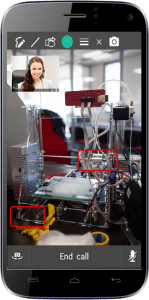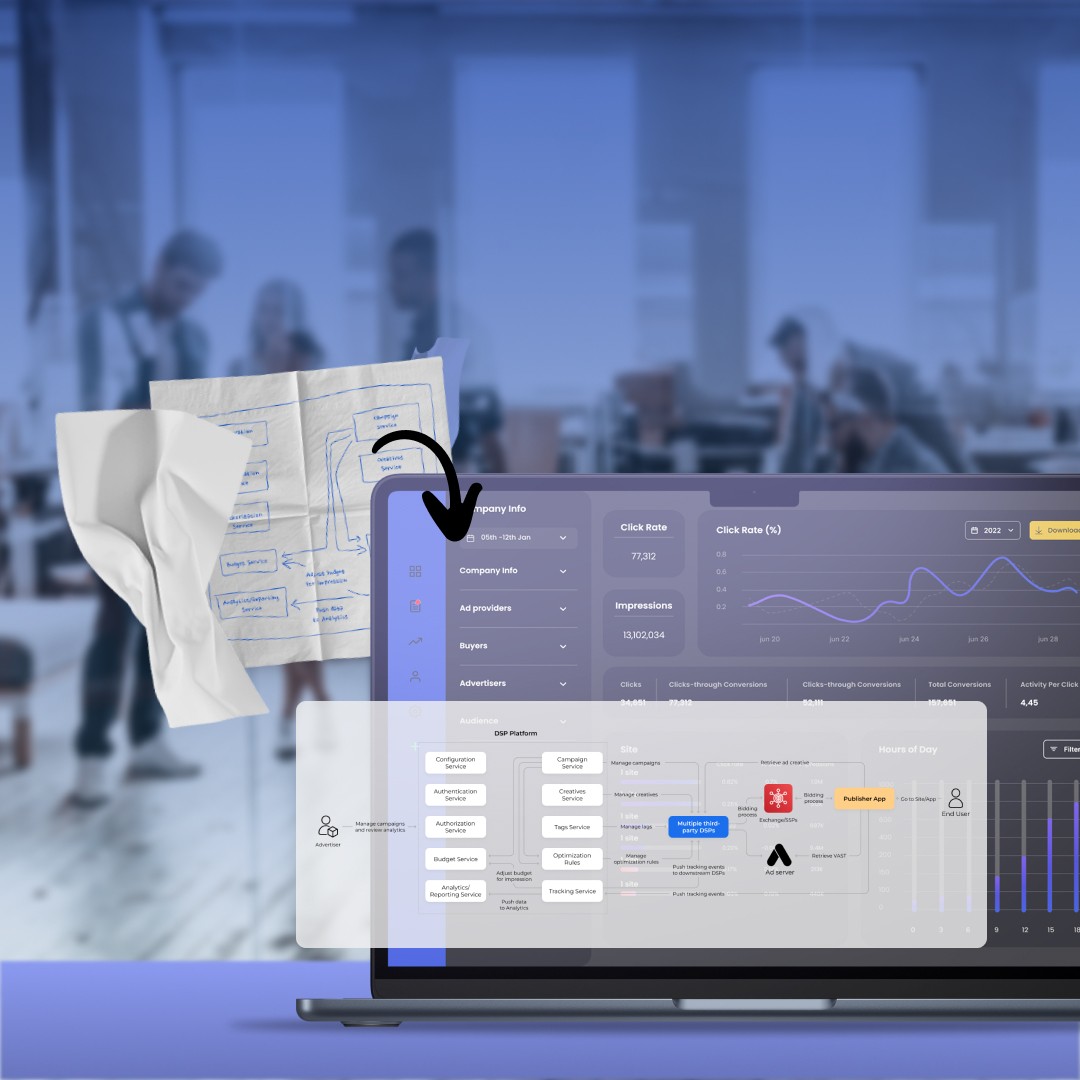
WebRTC allows for video calls and screen sharing through a web browser, without the need for a plugin. This advancing technology is improving the effectiveness of e-learning, customer support, and just about any service that relies on real-time communication (RTC).
And a brilliant way to improve how users communicate is to augment RTC with annotations. In fact — it’s the nitty-gritty of implementing annotations that you’ll learn about in this guide.
And this is where TokBox comes in
The support for annotations is currently being developed by TokBox as a widget for their leading WebRTC cloud platform, known as OpenTok. This groundbreaking widget was announced in late 2015, and it’s still in beta at the time of this writing.
TokBox’s Annotation Widget includes the following features:
- The ability for both the publisher and subscriber(s) to annotate a shared video stream.
- Annotations work seamlessly across web and mobile clients.
- Screen capture capabilities.
- Predefined drawing tools and custom shapes.
- Annotation thickness and color are adjustable on-the-fly.
TokBox’s platform is appealing, because their SDKs are available for iOS and Android, and they’ve even developed a plugin for Microsoft’s Internet Explorer. So as we wait for browser vendors to adopt the proposed WebRTC standards, a RTC application built upon OpenTok can support a range of devices today.
So now that an overview of real-time annotations has been given, let’s jump into a hands-on exploration of the Annotation Widget’s JavaScript library.
Initial setup with OpenTok
To start working with WebRTC annotations in 5 – 10 minutes, just follow our step-by-step instructions for deploying the OpenTok widget on Heroku’s Cloud PaaS for free:
- Go to TokBox’s GitHub page for the Annotation Widget, and click Deploy to Heroku.
- Log in to Heroku’s platform or sign up for their free account.
- Heroku will request the following configuration variables for your web application: an API Key, Session ID, and Token. These values can be generated or retrieved from your TokBox Dashboard.
- Click Deploy for Free, and navigate to your app URL within a browser that supports WebRTC.
To modify your Heroku application, click on the OpenTok app listed on your Heroku Dashboard, then click the Deploy tab. Here you’ll find clear instructions for syncing local code changes through Dropbox, GitHub, or Heroku’s Toolbelt.
Widget options
TokBox’s Annotation Widget is available to the browser client through a customizable toolbar. And the toolbar is represented within JavaScript as a configurable object:
// Initialize a toolbar for controlling annotation canvases
toolbar = new OTSolution.Annotations.Toolbar({
session: session,
container: document.getElementById('toolbar'),
colors: palette,
items: [] // Menu items are defined within this collection
{)
The annotation toolbar can be configured with several predefined menu items:
- Pen Tool: for free-form drawings.
- Line Tool: for drawing from point-to-point.
- Shape Tool: for drawing both predefined and custom shapes.
- Color Palette: a selection of user-defined annotation colors.
- Lines: a dropdown selection for changing annotation thickness.
- Clear function: removes all annotations made upon a video broadcast.
- Screen Capture: captures the image data of an annotated video frame.
Adding menu items, changing icons, or adjusting the color palette is straightforward to accomplish. Here’s an example of how a custom Pen Tool icon can be specified:
// Initialize a toolbar for controlling annotation canvases
toolbar = new OTSolution.Annotations.Toolbar({
session: session,
container: document.getElementById('toolbar'),
colors: palette,
items: [ // Menu item configuration
{
id: 'OT_pen',
title: 'Pen',
icon: 'image/draw39.png',
selectedIcon: 'image/draw39-gray.png'
},
...
]
...
})
Custom event handlers
Event handlers enable significant control over the Annotation Widget’s behavior. Menu item click events propagate the menu item ID to a predefined callback. And it’s here where custom event handlers should be defined:
toolbar.itemClicked(function (id) {
// Handle the event
});
If you want to display a custom color palette when clicking the Colors menu item, this is how an event handler can do so:
// Callback for handling menu actions
toolbar.itemClicked(function (id) {
console.log("Callback item id: " + id);
if(id == 'OT_colors')
{
//show custom color picker (jscolor.com)
document.getElementById('toolbar-palette').jscolor.show()
}
});
Note that the screen capture event has a special callback:
// Callback for screen capture event
canvas.onScreenCapture(function (dataUrl) {
var win = window.open(dataUrl, '_blank');
win.focus();
});
By making the image’s dataUrl available to the above function, it’s possible to integrate sharing tools (Tweeting, Facebook, email, etc.), or to persist an image to a cloud drive via Dropbox’s API.
Creating custom shapes
The Annotation Widget is not limited to predefined drawing tools. A shape can be specified through a collection of line points. For a great example of this, take a look at how a star is defined:
// Initialize a toolbar for controlling annotation canvases
toolbar = new OTSolution.Annotations.Toolbar({
items: [
{
id: 'OT_shapes',
title: 'Shapes',
icon: 'image/shapes.png',
items: [
{
id: 'OT_star',
title: 'Star',
icon: 'image/star.png',
points: [
[0.5 + 0.5 * Math.cos(90 * (Math.PI / 180)),
0.5 + 0.5 * Math.sin(90 * (Math.PI / 180))],
[0.5 + 0.25 * Math.cos(126 * (Math.PI / 180)),
0.5 + 0.25 * Math.sin(126 * (Math.PI / 180))],
[0.5 + 0.5 * Math.cos(162 * (Math.PI / 180)),
0.5 + 0.5 * Math.sin(162 * (Math.PI / 180))],
[0.5 + 0.25 * Math.cos(198 * (Math.PI / 180)),
0.5 + 0.25 * Math.sin(198 * (Math.PI / 180))],
[0.5 + 0.5 * Math.cos(234 * (Math.PI / 180)),
0.5 + 0.5 * Math.sin(234 * (Math.PI / 180))],
[0.5 + 0.25 * Math.cos(270 * (Math.PI / 180)),
0.5 + 0.25 * Math.sin(270 * (Math.PI / 180))],
[0.5 + 0.5 * Math.cos(306 * (Math.PI / 180)),
0.5 + 0.5 * Math.sin(306 * (Math.PI / 180))],
[0.5 + 0.25 * Math.cos(342 * (Math.PI / 180)),
0.5 + 0.25 * Math.sin(342 * (Math.PI / 180))],
[0.5 + 0.5 * Math.cos(18 * (Math.PI / 180)),
0.5 + 0.5 * Math.sin(18 * (Math.PI / 180))],
[0.5 + 0.25 * Math.cos(54 * (Math.PI / 180)),
0.5 + 0.25 * Math.sin(54 * (Math.PI / 180))],
[0.5 + 0.5 * Math.cos(90 * (Math.PI / 180)),
0.5 + 0.5 * Math.sin(90 * (Math.PI / 180))]
]
}
]
},
...
]
...
})
Overall thoughts
The Annotation Widget is in beta for a reason. Significant functionality is still missing, and a few usability quirks exist. Most notably, native support for moving and resizing on-screen annotations is lacking, and the Pen Tool is not always 100% accurate.
However, there’s huge potential for WebRTC annotations. Especially if the feature set expands to what users have come to expect within modern annotation tools; highlighting, annotation resizing, and smoother brush strokes. Features that we anticipate to see once TokBox’s widget is out of beta.
And the OpenTok Annotation Widget is just another reason for why we’re proud to be an official partner of TokBox, here at Oxagile. So if you’re in need of a custom WebRTC solution for your business — contact us today — and learn how our software development services can meet your needs.






















